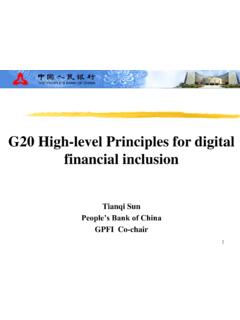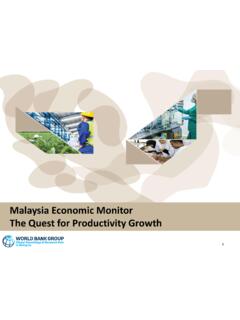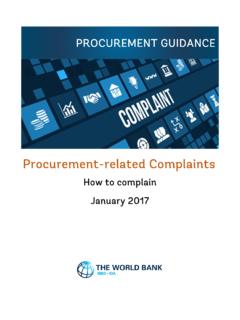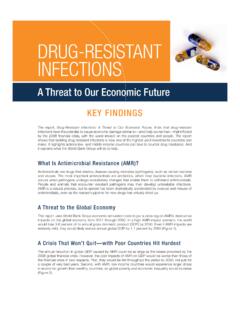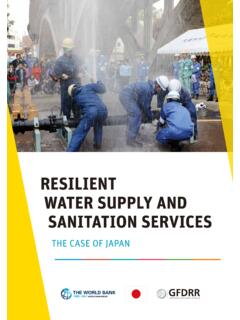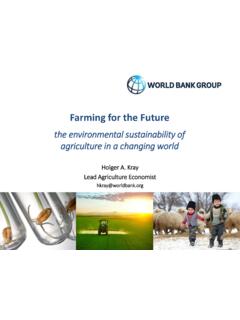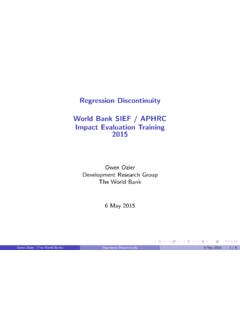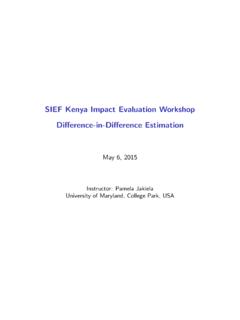Transcription of MIGRATION AND REMITTANCES - World Bank
1 MIGRATION AND DEVELOPMENT BRIEF 27 APRIL 2017 MIGRATION AND REMITTANCESR ecent Developments and OutlookSpecial Topic: Global Compact on MigrationMigration and Development Brief reports an update on MIGRATION and remittance flows as well as salient policy developments in the area of international MIGRATION and development. The Global Knowledge Partnership on MIGRATION and Development (KNOMAD) is a global hub of knowledge and policy expertise on MIGRATION and development. It aims to create and synthesize multidisciplinary knowledge and evidence; generate a menu of policy options for MIGRATION policy makers; and provide technical assistance and capacity building for pilot projects, evaluation of policies, and data collection.
2 KNOMAD is supported by a multi-donor trust fund established by the World Bank. Germany s Federal Ministry of Economic Cooperation and Development (BMZ), Sweden s Ministry of Justice, MIGRATION and Asylum Policy, and the Swiss Agency for Development and Cooperation (SDC) are the contributors to the trust views expressed in this paper do not represent the views of the World Bank or the sponsoring queries should be addressed to KNOMAD working papers, policy briefs, and a host of other resources on MIGRATION are available at AND DEVELOPMENT BRIEF 27 MIGRATION and REMITTANCES : Recent Developments and OutlookSpecial Topic: Global Compact on MigrationApril 2017 ContentsSUMMARY.
3 V1. TRENDS IN GLOBAL REMITTANCE FLOWS .. REMITTANCES in 2016 .. Outlook and Risks .. Trends in the Cost of REMITTANCES ..42. MIGRATION ISSUES .. Large Movements of Refugees and Migrants .. Spotlight on Worker-Paid Recruitment Costs ..103. SPECIAL TOPIC: ENVISIONING THE GLOBAL COMPACT ON MIGRATION .. Defining the Global Compact on MIGRATION .. Identifying Thematic Priorities ..13 ANNEX A: DATA NOTES AND FORECAST METHODOLOGY ..17 Data on REMITTANCES ..17 Caveats ..17 Estimating REMITTANCES for 2016 ..18 Methodology for Forecasting REMITTANCES ..18 Data on Remittance Prices, Refugees, GDP, and Other Variables ..19 ANNEX B: REGIONAL TRENDS IN MIGRATION AND REMITTANCE FLOWS.
4 21 REMITTANCES to East Asia and the Pacific (EAP) Face Global Headwinds ..21 REMITTANCES to Europe and Central Asia (ECA) Projected to Increase in 2017 ..22 Remittance Flows into Latin America and the Caribbean (LAC) Picked Up in 2016 ..23 REMITTANCES to the Middle East and North Africa (MENA) Region Declined Further in 2016 ..24 REMITTANCES to the South Asia Region (SAR) Declined in 2016 Due to Low Oil Prices ..26 REMITTANCES to Sub-Saharan Africa (SSA) Decelerated in 2016 ..27 ANNEX C: COMPARATIVE SUMMARY OF THEMATIC ELEMENTS FOR THE GLOBAL COMPACT ON MIGRATION ..29 References .. , FIGURES, TABLEST able Estimates and Projections for Remittance Flows to Developing Country Regions.
5 2 Figure Top Remittance Receivers in 2016 ..3 Box : Why Taxing REMITTANCES Is a Bad Idea ..4 Figure The Cost of Sending $200 Has Remained Nearly Flat ..5 Figure Sub-Saharan Africa Continues to Have the Highest Cost of Sending $200 ..6 Table Major Mergers and Financial Deals in the Global Money Transfer Industry, 2013 17 ..7 Figure First-Time and Pending Asylum Applications in the EU-28 ..9 Figure Refugee Stock in EU-28 and Worldwide ..10 Figure Recruitment Costs and Recruitment Cost Index: Pakistan to Saudi Arabia Construction Workers ..11 Box : Developments on the Global Compact on China Is the Top Recipient of REMITTANCES in East Asia and the Pacific but Pacific Islands Are More Dependent on REMITTANCES .
6 21 Figure Several ECA Countries Depend Heavily on REMITTANCES ..23 Figure Remittance Inflows to Latin America Were Strong, Led by Mexico ..24 Figure Impact of the Decline in REMITTANCES from Gulf Cooperation Council Countries ..25 Figure REMITTANCES to Countries in the South Asia Region Are Large in Absolute Terms and Relative to Gross Domestic Product ..26 Figure Countries in Sub-Saharan Africa with High Remittance Inflows and REMITTANCES as a Percentage of Gross Domestic Product ..28v SummaryThis MIGRATION and Development Brief provides an update on worldwide remittance flows and the global MIGRATION crisis. It focuses on two Sustainable Development Goal (SDG) indicators: reducing remittance costs, and reducing recruitment costs for low-skilled migrants.
7 In September 2016, the United Nations General Assembly Summit on Large Movements of Refugees and Migrants committed to develop two global compacts: a Global Compact on Refugees, and a Global Compact for Safe, Orderly, and Regular MIGRATION . Negotiations on both compacts are expected to continue through 2017, with final adoption expected at a United Nations international conference in 2018. The Brief reports on progress in the preparation of the global compacts, with an expanded discussion of the Global Compact on MIGRATION . Remittance trends. For the first time in recent history, remittance flows to developing countries registered a decline for two successive years.
8 REMITTANCES declined by an estimated percent, to $429 billion, in 2016, after a decline of 1 percent in 2015. India, the largest remittance-receiving country worldwide, led the fall with a decrease of percent in remittance inflows. Cyclical factors affecting remittance flows, especially to South Asia and Central Asia, include low oil prices and weak economic growth in the Gulf Cooperation Council (GCC) countries and the Russian Federation. Weak growth in Europe also affected flows to North Africa and Sub-Saharan Africa. The decline in remit-tances is further accentuated when expressed in dollars because of the weakening of the euro, the British pound and the ruble against the dollar.
9 Remittance flows to the Europe and Central Asia region registered a significant decline for the third consecutive year; these flows have fallen by 30 percent since 2013. Latin America and the Caribbean was the only region to register an increase ( percent) in remittance flows, supported by strengthening employ-ment levels in the United States. Against the backdrop of weak exports and falling levels of international reserves, several remittance recipient countries imposed exchange controls, which gave rise to black market exchange premiums and an apparent shift in remittance flows to informal channels. In addition, structural constraints, such as de-risking behavior by international correspondent banks, continued to increase the regulatory burdens on money transfer operators, especially smaller and newer players.
10 Finally, labor market nationalization policies in the GCC countries and anti-immigration sentiments in many high-income nations discouraged the hiring of foreign workers and dampened remittance flows, especially through formal channels. Recently, several high-income countries that are host to many migrants are considering taxation of outward REMITTANCES , in part to raise revenue, and in part to discourage undocumented migrants. The list of coun-tries where such taxes are being considered includes Bahrain, Kuwait, Oman, Saudi Arabia, the United States, and the United Arab Emirates. However, taxes on REMITTANCES are difficult to administer and likely to drive the flows underground.

